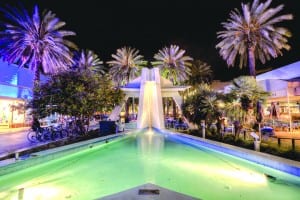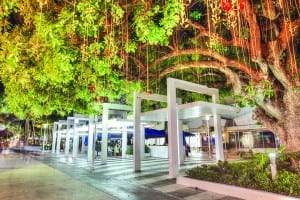
In a city filled with playful architecture, no group of buildings may be more fun than the follies that meander down the middle of Lincoln Road.
As early as the First World War, Lincoln Road was the premier shopping street in Miami Beach. The city’s founder, Carl Fisher, laid it out as a broad thoroughfare flanked by wide sidewalks, cutting eastwest across the narrow island to link the hotels along Biscayne Bay with the estates facing the Atlantic Ocean. Some of the few gilded-age buildings that survived the 1926 hurricane, such as August Geiger’s 1926 Fisher Tower (which recently housed the Van Dyke restaurant) give a sense of the opulence Fisher intended for his showcase avenue. The reconstruction of Miami Beach that followed the storm brought Lincoln Road some of the city’s most splendid art deco buildings, like the Lincoln and Colony Theaters.
But the heyday of the 1930s and ‘40s passed, and by the mid-1950s the shops along Lincoln Road had fallen on hard times, their sales sapped by the stores that had opened within the exquisite resort hotels to the north, like the Fontainebleau. Facing fiscal ruin, the merchants of Lincoln Road asked the Fontainebleau’s architect, Morris Lapidus, to propose changes to the street that would bring back shoppers. Lapidus’s radical response was to banish automobiles from the roadway (since, as he quipped, “a car never bought anything”) and turn Lincoln Road into a lushly landscaped pedestrian promenade.

The new streetscape combined playful follies (concrete shade structures) with fountains and tropical plantings. Each block is furnished with a unique pavilion and arrangement of planters. Their fanciful forms make them seem like remnants of a space-age world’s fair, and their visual language of slender concrete slabs, energetic geometries, and brightly painted white surfaces recalls the contemporaneous construction of Oscar Niemeyer’s government buildings in Brasilia. In this way, the follies amplify the inventive play on modernist forms that Lapidus explored in his earlier hotels. Lapidus came to Miami from New York in the 1940s and was as enamored of his adopted city’s brilliant sunlight and subtropical climate as he was of its cosmopolitan position on the cusp between the United States and Latin America.
Lapidus responded to this context by developing an architecture that reflected the glamour of international travel and the optimism of a young and growing city in a prosperous country. He gave shape to a modernism that celebrated the new technologies that were changing the world, and Florida’s role in them. After all, Lincoln Road was inaugurated in 1960, two years after Pan American Airways began flying passengers in the first broadly successful commercial jet airliner, the Boeing 707, and just a year before Alan Shepherd flew into space in a Mercury capsule launched from the Sunshine State.
The bandstand/fountain may be the most exuberant of Lapidus’s pavilions. The dramatically cantilevered roof slopes upward to the west, covering the performers and projecting sound to the audience on that side, while draining rain water down into a basin to the east. Pumps recirculate this water throughout the day, turning the folly into an enormous fountain. Like all of the follies along Lincoln Road, the bandstand has been appropriated as al fresco seating for neighboring restaurants. The proliferation of restaurants along Lincoln Road is testament to the financial success of Lapidus’s design; the fact that his streetscape’s playful energy is still legible through the cacophony is testament to its architectural excellence.






